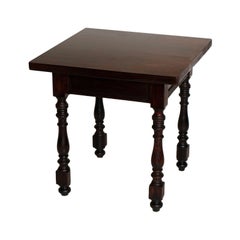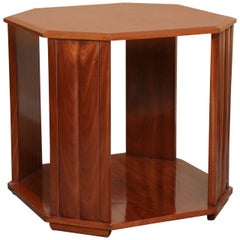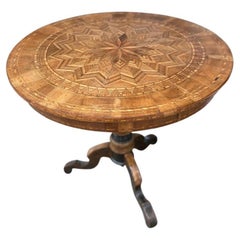Artistic & myArtistic End Tables
to
Height
to
Width
to
Depth
to
3
3
1
1
1
2
2
3
2
2
1
3
2
1
3
3
3
Italian 19th Century Occasional Umbertino Square Table All Solid Ebonized Pine
Located in Vigonza, Padua
Country Italian late 800 occasional Umbertino square table, all in solid ebonized pine, polished to wax
Measures cm: H 80 x W 80 x D 80.
Category
Antique Late 19th Century Italian Neoclassical Revival End Tables
Materials
Pine
1910s Oval Viennese Occasional Table by Wiener Werkstätte, Solid Walnut Restored
By Josef Hoffmann
Located in Vigonza, Padua
Early 20th century oval Viennese occasional table from Wiener Werkstätte, solid walnut restored, attributed to architect Josef Hoffmann designer
Measures cm: H 76, W 70, D 52
"...
Category
Early 20th Century Austrian Art Nouveau Side Tables
Materials
Walnut
Early 20th Century Side Occasional Table Art Decò in Solid Pine wax polished
Located in Vigonza, Padua
Early 20th century little side occasional table in solid pine, restored and wax polished
Style and period Art Deco
Measure in cm: H 70 W 60 D 40.
Category
Early 20th Century Italian Art Deco Side Tables
Materials
Pine
Related Items
Art Deco Walnut Side Table
Located in New York, NY
The octagonal top with radiating parquetry inlay; raised on four canted paneled supports joined by a platform stretcher on block feet. Lovely faded color and lively timber.
Category
Vintage 1930s French Art Deco Side Tables
Materials
Mahogany
Very fine 19th Century Italian Walnut Marquetry Tripod Occasional Table
Located in Petworth,West Sussex, GB
A very fine antique 19th century Italian walnut marquetry pedestal tripod occasional table, from the Sorrento region in fine walnut marquetry ...
Category
Antique 19th Century Italian Tables
Materials
Walnut
Walnut Square Occasional Glass Top Center Side Table
By Milo Baughman, Jens Risom
Located in Rockaway, NJ
Nice Mid-Century Modern square side table with glass top. Measures: 31 x 31".
Category
20th Century American Mid-Century Modern Side Tables
Materials
Glass, Walnut
Early 20th Century Anglo Indian Occasional Table
Located in London, GB
Early 20th Century Anglo Indian occasional table
We share what we love, and we love this aged hard wood example of a large Anglo Indian hard...
Category
Vintage 1920s Indian Victorian End Tables
Materials
Wood
Early 20th Century Hand Crafted Indian Occasional Cupboard Table
Located in London, GB
Early 20th Century Hand Crafted Indian Occasional Cupboard Table
An authentic first quarter 20th century Indian hand-crafted occasional table, with hidden cupboard section underne...
Category
Vintage 1930s Indian Late Victorian Side Tables
Materials
Wood
French Art Deco Burl Walnut Occasional or Side Table
Located in New York City, NY
French Modernist stepped two tier cubist end table in bookmatched walnut. The top surface raised on bull nose plinths, while the bottom tier is supported by alternating curved and sq...
Category
Early 20th Century French Art Deco End Tables
Materials
Walnut
Unique Side Table Tourned Legs Spain 20th Century or Early 20th Century
Located in Mombuey, Zamora
Beautiful Side or end table, In very good conditions.
This table is raised on a base composed of four turned legs
Lovely side table features tourned legs, early 20th Century
Un...
Category
Early 20th Century Spanish Spanish Colonial Side Tables
Materials
Walnut
$2,896
H 28.35 in W 26.78 in D 23.63 in
Solid Walnut Rectangular Side Tables, a Pair
Located in Germantown, MD
A pair solid walnut rectangular side tables.
Measure 17.75" in width x 11.75" in depth x 18" in height.
Very good vintage condition.
Category
Late 20th Century American Modern Side Tables
Materials
Hardwood
Early 20th Century English Pine Side Table
Located in Burton, TX
This Early 20th century English Side Table is constructed of aged English Pine. The piece features four hand grooved tapered legs that rest on four aged brass casters. This side tabl...
Category
Early 20th Century English Side Tables
Materials
Pine
American Occasional Table
Located in Dallas, TX
American Occasional Table, attributed to Karl Springer.
Having and oval top raised on twin round supports, woven finish.
Category
20th Century End Tables
Materials
Hardwood
19th C. French Charles X Restoration Period Sewing Stand Work Table
Located in Forney, TX
A scarce period Charles X (1818-1834) French Restoration mahogany travailleuse sewing (thread stand - side table - jewelry dressing table) with light, warm, beautifully aged patina.
Born in France in the early 19th century, almost certainly Parisian work, exquisitely hand-crafted, this exceptionally executed example features ornate gilt bronze ormolu mounts, escutcheons, and elaborate gilt metal trim. Having a highly figured light mahogany hinged lid top, lifting open to reveal a striking finished interior with divided compartments and original inset mirror plate. The conforming rectangular case fitted with a faux drawer front over a dovetailed drawer with sectioned interior. Elegantly rising on oval-shaped medial shelf stretcher-joined curvacious legs.
Dimensions (approx):
27" High, 20" Wide, 13.5" Deep
Stunning light almost blonde antique mahogany coloring and mellow warm tone, superb wood grain detail, and charming, beautifully aged patina over the whole. Great shape overall. Retaining original antique character marks, wear consistent with age and indicative of minimal use, nothing that detracts from the aesthetics or functionality, but only adds to the overall authenticity, refined elegant warmth, luxurious sophistication, and cozy unpretentious rustic elegance.
Delivered cleaned, hand waxed, polished French patina finish, ready for immediate use and generational enjoyment!
What is Charles X style:
The comte d’Artois – or Charles X - was the son of the dauphin Louis-Ferdinand de Franc and Marie-Josèphe de Saxe. He succeeded his two brothers Louis XVI and Louis XVIII and became the King of France in 1824. Thirty years after the French Revolution, he wanted to embody the return of monarchy and became the leader of the catholic party . As the previous kings, he was crowned in 1825 but he was soon overthrown by the revolution in July, 1830, called "Trois Glorieuses". He left then for England, Scotland, Prague and Istria where he died in 1836.
Charles X style lasted from 1818 to 1834 and happened during the Bourbon Restoration (French Restoration). This style did not replace totally the style of furniture from the French Empire but it was different from the formalism in the Napoleonic era, during which strictness and simplicity were inspired by Greco-Roman art. Indeed, artistic fields flourished. In terms of furniture, this renewal was suggested by the softening of shapes. Even though the simple aspect from the French Empire was still visible, shapes became curvier with volutes and arabesques. Another distinction is the loss of the massive aspect of furniture and the decrease of dimensions in order to decorate smaller appartments. Handling ability and comfort were key-words in the making of furniture. Apartments had essential elements such as chests of drawers, big rounded tables in the dining room, desks or secretaries, armoires and even dressing tables, comfortable fainting couches in the living room, small tables, pedestal tables, as well as gondola chairs. The wavy aspect of the latters certainly represent Charles X style the best.
One of the most emblematic features of this style is the use of bois clairs – light woods in warm blond tones - and indigenous woods that are varnished in order to highlight the grains. Bird's-eye maple, ash trees, plane trees, yew trees, beech trees, olive trees and cedar trees were most likely to be used. Indeed, at the beginning of the 19th century dark woods were hard to find. In 1806, the Napoleon’s Continental System was established in order to ruin the United Kingdom by preventing the country from any business with the rest of Europe. Therefore craftsmen had to find alternatives from mahogany which was the most commonly used material at this time. After 1815, the import of wood was even more difficult because of peace treaties and the European political situation, which contributed to the popularity of the bois clairs and indigenous woods. The furniture was often decorated with fine inlays made out of dark wood representing foliage, which contrasted with the veneer. Even though these patterns can look like bronze decorations from the Empire era, they were far more simple and did not represent any military or mythological attributes. On the tables, trays were sometimes made out of marble as in the French Empire, but it was often put aside and inlaid veneer, Verre Eglomisé – a type of glass with a mirror finish –, mirror or porcelain from Sèvres or Paris were more likely to be used.
Decorative elements from the Monarchy were highly appreciated again as they suggested luxury. Indeed, marquetry work was particularly fashionable - Boulle marquetry thrived around 1820 as the works of the Levasseur family can show. In the same way, draperies and trimmings referred to the monarchist splendour. Fabrics were often white – the traditional colour of the Bourbons – or light coloured as oppposed to the typical green from the Napoleonic era.
One of the most symbolic figures from this period of time might be Jean-Jacques Werner (1791-1849), a cabinetmaker who worked for prestigious clients such as the Duchesse de Berry who was Charles’s step-daughter. His works can be seen at the Musée des Arts Décoratifs and at the Grand Trianon in the Palace of Versailles. The duchess’s appartments situated at the pavillon de Marsan and at the Palais de Saint Cloud illustrate Charles X style the best with furniture made out of bois clairs and ornamented with dark wood patterns or fine gold decorations.
Chales X style allows a transition between the sobriety of the Empire style and the abundant aspect of Louis-Philippe style. The gothic style started at this time through the "style à la cathédrale", inspired by religious architecture, which thrived from 1827 to 1830. Indeed, at the beginning of the 19th century, Romanticism put the spotlight on the Middle Ages. Cabinetmakers were not inspired by the medieval furniture but rather by architectural elements of churches and cathedrals. For instance the backs of chairs were decorated with arches shaped like rib and serration. In the same way, before Charles X abdicated, pieces of furniture were made out of dark woods – such as mahogany, which was used again in France – and were inlaid with light wood. Romanticism also influenced the layout of furniture in appartments to suggest movement through a mix of various styles, various shapes and various sizes, as opposed to the static aspect of Neoclassicism. The start of industrialisation and mechanisation also influenced this style as early technical developments led to the production of pieces of furniture in series.
Credit:
Marc Maison
Bibliography:
FANIEL Stéphane (Dir.), Le Dix-neuvième Siècle Français, Collection Connaissance des Arts, 1957, Hachette
SASSONE, Adriana Boidi, Furniture from Rococo to Art Deco, 2000, Evergreen
--
Extremely versatile:
As warm and attractive as it is useful, this remarkable antique table having the ideal size and small proportions for a variety of different uses, including as a side table, accent or occasional table, tall sofa...
Category
Antique Early 19th Century French Charles X End Tables
Materials
Bronze, Ormolu
19th Century Chess Board Occasional Table
Located in London, GB
A mid nineteenth century occasional table with octagonal marquetry chess board top, the turned upright supported by a marquetry tripod base on bu...
Category
Antique Mid-19th Century English Tables
Materials
Wood



